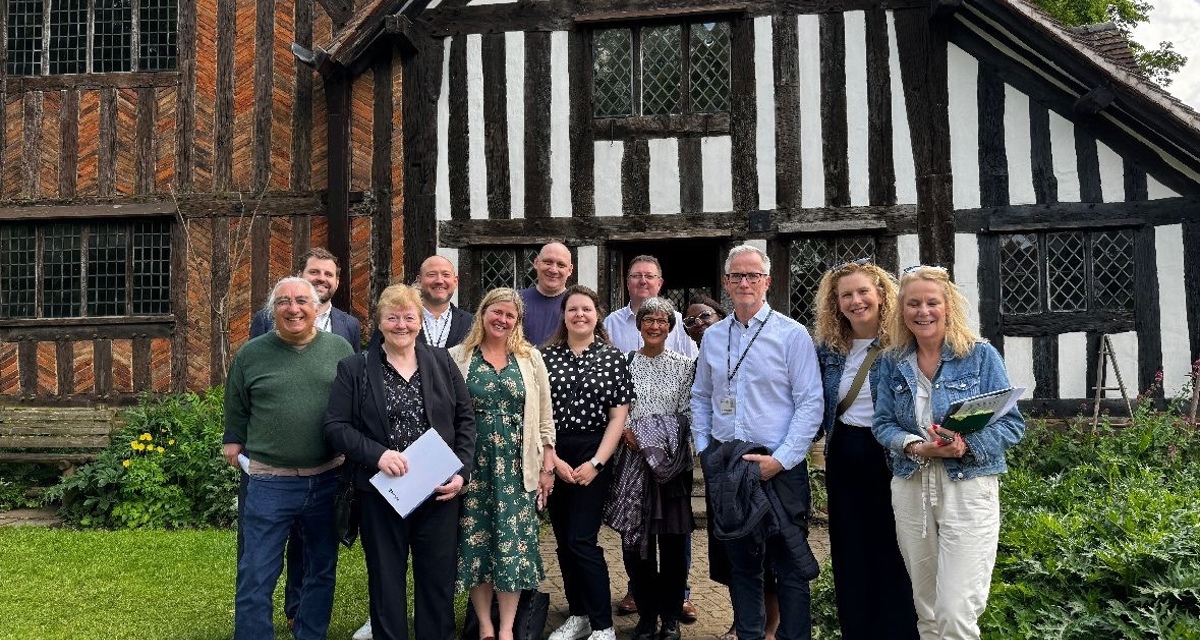19 Jun 2024
Bournville Village Trust: An enduring commitment to people and place

CIH recently paid a visit to Birmingham’s famed Bournville village, where the founding principles of wellbeing and community are just as visible today as they were more than 100 years ago.
All too often, we hear stories where poor planning or siloed thinking leads to unsuitable living conditions or homes that aren’t fit for purpose. Our visit to Bournville shows what setting up a community for success looks like, and how we could emulate that elsewhere.
We were lucky enough to have with us Bournville Village Trust (BVT) chair Caroline Cadbury, whose family founded Bournville, to explain the radical social decisions that led to the creation of this picturesque village famed for its chocolate-making.
Pioneering placemaking
The emphasis on placemaking at Bournville back in 1878 created a healthy and happy place, not only for Cadbury workers, but the wider community, a legacy still visible today. Everyone at BVT – which in total manages around 8,000 homes – is passionate about their history, as seen through the Selly Manor Museum, which proudly engages with local people and visitors to share their story.
Walking around Bournville on a sunny day, you feel the intentionality behind the place. The access to nature with parks and recreation areas encourages a healthy lifestyle, following on from the public health experiment that started more than 100 years ago.

CIH has advocated for the importance of healthy homes contributing to wellbeing, and you can see the positive consequences of considering these principles in the community of Bournville. These core beliefs align with the founding history of CIH, with likewise radical social thinkers like Octavia Hill recognising the role of housing in reforming people’s lives.
BVT has an estate design guide that all residents sign up to, which helps to maintain and conserve the character of the area, whilst ensuring its green spaces and openness remain. This also allows residents to pursue environmental sustainability and BVT to innovate to meet the needs of residents both today and in the future.
BVT understands the value of engaging with residents and ensuring their agency in decision-making. Throughout our visit, we heard of their focus on people and meeting the needs of specific communities within Bournville.
Chief executive Pete Richmond explained how they aim to break the cycle of decline and deprivation that often follows area transformation projects, by including a community focus and holistic place shaping, alongside good infrastructure and design.
Richard Clark, head of housing and neighbourhoods and our visit organiser, explained everything they do focuses on people-centred places, which stems from the mission statement of “creating and sustaining communities where people can thrive”. It helps all within the organisation understand that both new developments and existing areas need to be cared for through building partnerships and brokering relationships between the mix of communities and tenures living in Bournville.
We visited a BVT community centre that showed the passion staff have for engaging with local people and helping them to develop and thrive. There are plans to use nearby overgrown land to create a community garden; they are offering the centre space for exercise classes and social groups for children with additional needs; and they have a litter-picking volunteering group to encourage care and pride in the local area.
Each activity is explained with care and the understanding that they are serving the local people and helping them to succeed however they can.
The most moving moment of the day came when we visited the Holdings, a supported housing facility for 16- to 21-year-olds leaving the care system. The foundations provided through this facility to transform the lives of these young people was inspiring.
The team help with developing life skills such as cooking and budgeting to learn how to sustain a tenancy, and work with local institutions like the Queen Elizabeth Hospital to explore apprenticeship opportunities for future progression. The accommodation is fully furnished, and the contents belong to the residents, meaning they are setting them up for success and avoiding furniture poverty when moving into independent accommodation.
 Head of estates and stewardship Tracey Rowe speaking outside Weoley Hill Village Hall
Head of estates and stewardship Tracey Rowe speaking outside Weoley Hill Village Hall
There is also the Beeches, a former conference centre being repurposed to provide homes for families in temporary accommodation. In partnership with Spring Housing, they are using their existing spaces to meet the needs of the area, by tackling the housing shortage head on and supporting those without the stability and solid foundation a good home provides.
These are just some examples of how BVT are working to understand and meet the specific needs of their residents and the local area more widely.
A lasting legacy
What struck us most during our visit was the model from 120 years ago still worked and has set the area up for success. It showed the power in taking the time to ensure good placemaking, and that focusing on people can create a community that has the conditions to thrive.
Everyone at BVT knows they can’t simply focus on the past: they each must carry forward their organisation’s founding values to sustain its legacy and secure their community’s future.
- If you would like to work with CIH to organise a visit to your organisation, please contact Jill Allcoat
Megan Hinch is a CIH policy and practice officer who leads housing supply and finance.


